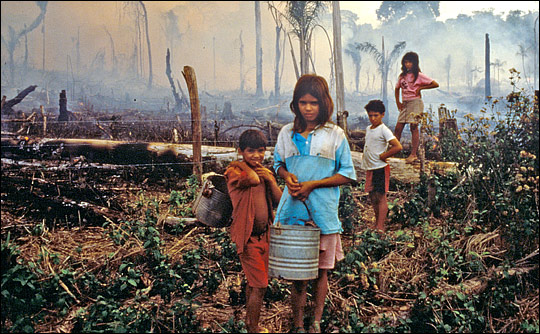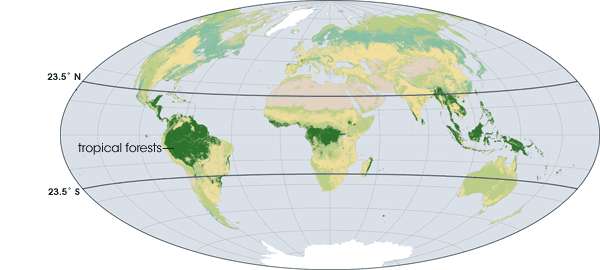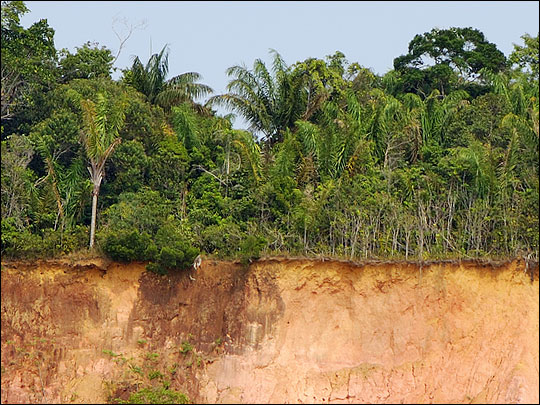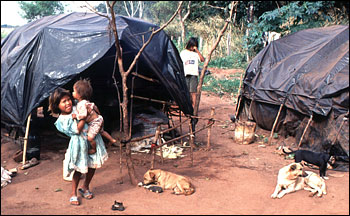

 | |||
Stretching out from the equator on all Earth’s land surfaces is a wide belt of forests of amazing diversity and productivity. Tropical forests include dense rainforests, where rainfall is abundant year-round; seasonally moist forests, where rainfall is abundant, but seasonal; and drier, more open woodlands. Tropical forests of all varieties are disappearing rapidly as humans clear the natural landscape to make room for farms and pastures, to harvest timber for construction and fuel, and to build roads and urban areas. Although deforestation meets some human needs, it also has profound, sometimes devastating, consequences, including social conflict, extinction of plants and animals, and climate change—challenges that aren’t just local, but global. NASA supports and conducts research on tropical forests from space-based and ground-based perspectives, helping provide the information that national and international leaders need to develop strategies for sustaining human populations and preserving tropical forest biodiversity. |
(Photograph courtesy U. S. Forest Service.) The original version of this fact sheet, by Gerald Urquhart, Walter Chomentowski, David Skole, and Chris Barber, and published in 1999, is archived as a PDF. | ||
 | |||
Impacts of Deforestation: Biodiversity ImpactsAlthough tropical forests cover only about 7 percent of the Earth’s dry land, they probably harbor about half of all species on Earth. Many species are so specialized to microhabitats within the forest that they can only be found in small areas. Their specialization makes them vulnerable to extinction. In addition to the species lost when an area is totally deforested, the plants and animals in the fragments of forest that remain also become increasingly vulnerable, sometimes even committed, to extinction. The edges of the fragments dry out and are buffeted by hot winds; mature rainforest trees often die standing at the margins. Cascading changes in the types of trees, plants, and insects that can survive in the fragments rapidly reduces biodiversity in the forest that remains. People may disagree about whether the extinction of other species through human action is an ethical issue, but there is little doubt about the practical problems that extinction poses. |
Tropical forests span both sides of the Equator, thriving in the warm, usually wet, climate, under the Sun’s most direct rays. Evergreen forests between the Tropic of Cancer (North) and Tropic of Capricorn (South) are dark green on this map, while other biomes are lighter. (Image by Robert Simmon, based on Moderate Resolution Imaging Spectroradiometer Land Cover Classification data.) | ||

First, global markets consume rainforest products that depend on sustainable harvesting: latex, cork, fruit, nuts, timber, fibers, spices, natural oils and resins, and medicines. In addition, the genetic diversity of tropical forests is basically the deepest end of the planetary gene pool. Hidden in the genes of plants, animals, fungi, and bacteria that have not even been discovered yet may be cures for cancer and other diseases or the key to improving the yield and nutritional quality of foods—which the U.N. Food and Agriculture Organization says will be crucial for feeding the nearly ten billion people the Earth will likely need to support in coming decades. Finally, genetic diversity in the planetary gene pool is crucial for the resilience of all life on Earth to rare but catastrophic environmental events, such as meteor impacts or massive, sustained volcanism. Soil ImpactsWith all the lushness and productivity that exist in tropical forests, it can be surprising to learn that tropical soils are actually very thin and poor in nutrients. The underlying “parent” rock weathers rapidly in the tropics’ high temperatures and heavy rains, and over time, most of the minerals have washed from the soil. Nearly all the nutrient content of a tropical forest is in the living plants and the decomposing litter on the forest floor. |
Tropical forests contain more species than any other ecosystem, as well as a higher proportion of endemic (unique) species. As people clear large areas of tropical forests, entire species are vanishing, many of them unknown. (Graph adapted by Robert Simmon from the Millennium Ecosystem Assessment Biodiversity Synthesis.) | ||
 | |||
When an area is completely deforested for farming, the farmer typically burns the trees and vegetation to create a fertilizing layer of ash. After this slash-and-burn deforestation, the nutrient reservoir is lost, flooding and erosion rates are high, and soils often become unable to support crops in just a few years. If the area is then turned into cattle pasture, the ground may become compacted as well, slowing down or preventing forest recovery. Social ImpactsTropical forests are home to millions of native (indigenous) people who make their livings through subsistence agriculture, hunting and gathering, or through low-impact harvesting of forest products like rubber or nuts. Deforestation in indigenous territories by loggers, colonizers, and refugees has sometimes triggered violent conflict. Forest preservation can be socially divisive, as well. National and international governments and aid agencies struggle with questions about what level of human presence, if any, is compatible with conservation goals in tropical forests, how to balance the needs of indigenous peoples with expanding rural populations and national economic development, and whether establishing large, pristine, uninhabited protected areas—even if that means removing current residents—should be the highest priority of conservation efforts in tropical forests. |
The organic material and nutrients in a tropical rainforest are found in the vegetation itself, not in the soil. This eroded hillside along a river in Amazonia shows the infertile soil typical of tropical environments (pinkish-tan) topped by a very thin layer of fertile soil and forest detritus (brown). (Photograph ©2007 Guenter Fischer and World of Stock.) | ||

|
Logging, mining, and farming in tropical forests sometimes displace indigenous communities. Left without land or other resources, native cultures often disintegrate. This displaced group of Guarani Indians lives in a makeshift camp along the road in Mato Grosso do Sul, Brazil. (Photograph ©2001 nagillum.) | ||